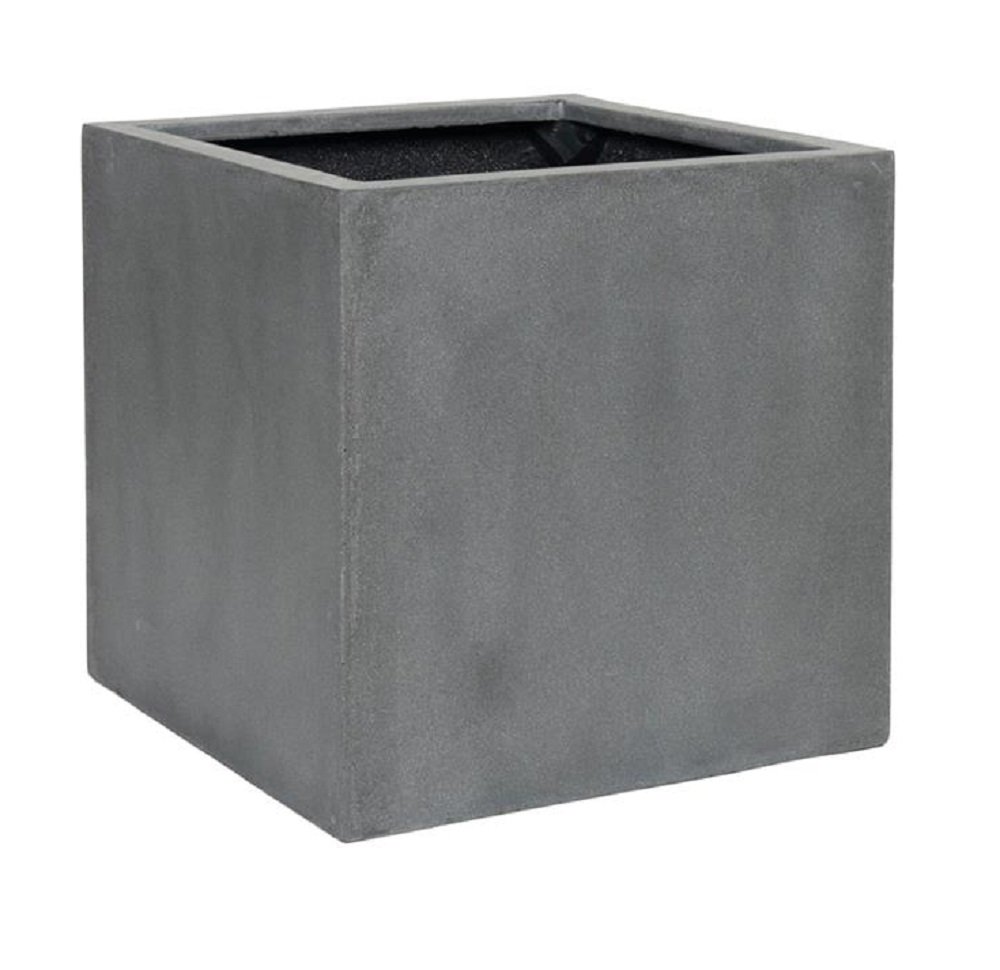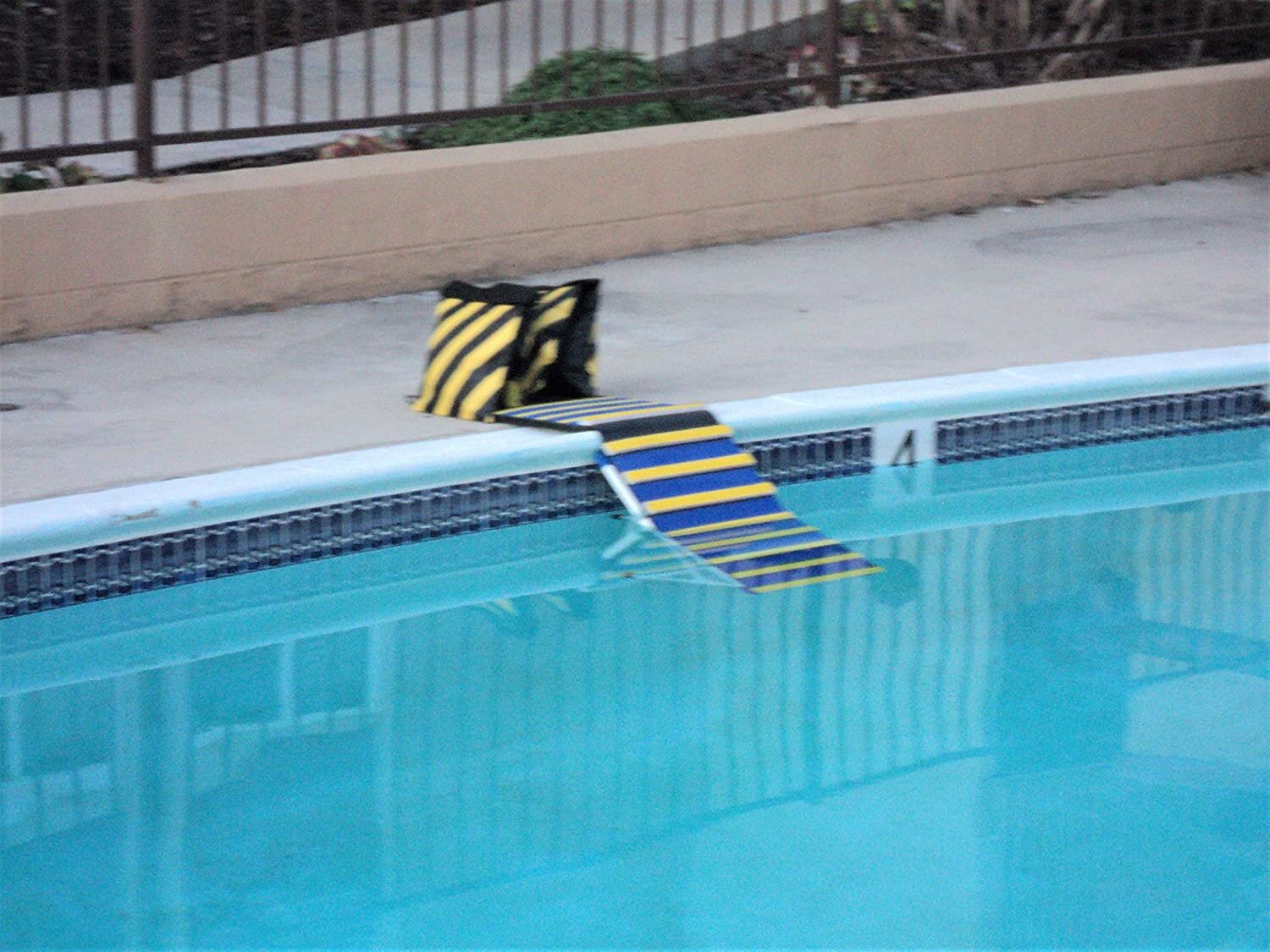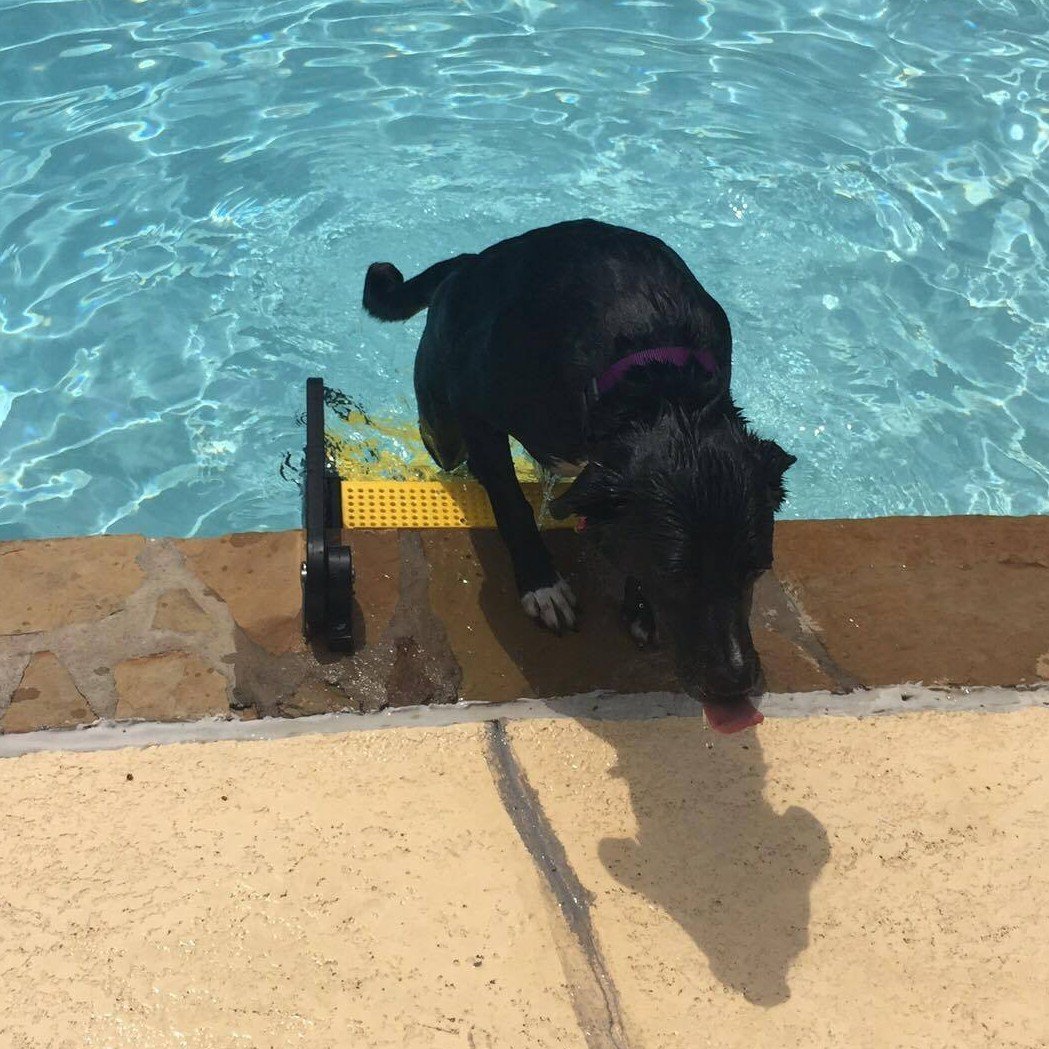Swimming & Pool/Water Safety
Dogs & Swimming
Mark The Pool Exit
Steps
Ramps
Flotation Vests
Swimmers Tail
Water Intoxication
Salt Water Poisoning
Red Tides
Algae Blooms (Toxic to Dogs!)
Just as with children it is recommended to fence off the pool to help prevent accidents and supervise both children and dogs when around water. But a barrier is not a guarantee that a dog won’t gain access to a pool. Not every dog is safe around a pool. While most dogs will instinctively make a paddling motion in water only some dogs are natural swimmers, others can be taught to swim, and still others are not built for swimming. “Dogs that aren’t designed for swimming include “top heavy” breeds – those with large chests and small hindquarters. Short muzzled dogs, including the brachycephalic breeds, and dogs with very short legs also don’t do well in water.”
Even dogs belonging to breed groups known to be good swimmers and natural water dogs can have structural deficiencies that make swimming difficult so they may avoid anything to do with water.
Short neck pg 48
Long neck pg 48
Ewe neck pg 50
Slipped hocks pg 122
Narrow or pinched nostrils pg 44
Water Dogs structure pg 145
“Structure in Action” is an excellent resource to evaluate your dog’s structure.
We should never throw a dog into the water so they “learn” to swim and/or “get out” of the water. A dog that panics is not likely to learn anything more than we cannot be trusted. Older dogs and overweight dogs are at a greater risk due to the physical challenges of getting out of the water trying to climb out at the edge and not at a step or ramp. If there is not a set of dog steps or dog ramp clearly visible to exit a pool it’s a good idea to place something that is clearly visible at the exit points to help a dog locate the exit fast should they fall in.
Dogs that do not have dew claws are at a disadvantage getting out of the pool. The dew claws provide extra grip to pull themselves out.
Mark The Pool Exit
Dogs exposed to water should learn how to get out of the water so they don’t panic in or around water. But this needs to be done carefully so we don’t overwhelm the dog and lose their trust. Giving complete step by step guidance here is not realistic. But generally speaking I would start by teaching the dog at the exit of the pool/water to walk away immediately. After that was patterned maybe 6 times i would place the dog’s rear feet in the water and immediately (1/2 second) lead the dog out of the water on a leash without pulling. I would patterned this about 6 times and then place all four feet into the water and immediately (1/2 second) lead the dog out of the water on a leash without pulling. This is all done is a calm and upbeat manner without trying to “correct” a dog’s behavior. If we get our part right the dog when given a choice will not avoid us after this short training session.
To assist dogs with safely getting out of the water there are two primary options, steps and ramps.
WaterDog Adventure Gear ramps are sold through amazon and ebay. For the best price purchase directly form the company’s website. https://getwag.com/dog-pool-ladder/ A nice feature of their ramps is that the steps are yellow provide more contrast for dogs. (See Dogs Vision)
The offer a variety of pool, boat, and water ladders for dogs.
Skamper-Ramp large
Eliminate accidental drowning and keep unwanted critters and pests out of the pool. The Skamper-Ramp allows for an easy exit out of the pool for dogs.
Made from high quality HDPE plastic that's durable,heavy duty and lightweight.
Chemical and UV resistant. Will not yellow or crack.
Safe for vinyl or concrete pools, in or above ground.
Great for bulkheads, boats, floating docks, etc.
Made in USA.
The Skamper-Ramp is made by GAMMA2 the makers of Vittles Vaults. GAMMA2 makes a quality product here in the USA and are highly recommended. The Skamper-Ramp can be purchased at PetsWarehouse or amazon.
Whole Dog Journal
“Our top pick for athletic, accomplished swimmers is the West Marine Neoprene Pet Vest. We included this vest in our review due to its sleek design and its maker’s good reputation as a purveyor of boating-related products.”
“The vest is lightweight, flexible, and very form fitting, more like a wetsuit than a life vest.”
For dogs who are novice or weak swimmers, our top pick is Ruffwear’s K9 Float Coat.
“Kurgo’s Surf-n-Turf Coat looks similar to the Ruffwear K9 Float Coat but there are many differences between the two products. The top of the jacket features two sturdy handles, sewn at right angles to each other, so a person who was at any angle to the dog she was trying to fish out of the water is assured to be able to grab at least one of the handles – a thoughtful feature.”
https://www.whole-dog-journal.com/lifestyle/the-best-life-jackets-for-dogs
Limber tail syndrome is also called swimmers tail “occurs most often after swimming, but can also happen after a day of intense exercise, including hunting or other outdoor activities. Any activity in which your dog is using his tail a lot can trigger a limber tail.”
“If your dog has this condition, it can look like her tail is actually broken. However, the damage isn’t actually to the bones of the tail, but to the muscles. It’s a muscle injury typically brought on by overexertion of the tail.”
“While a limp tail can indicate an actual fracture, spinal cord injury or other problem, with limber tail, the onset is sudden – the dog’s tail was fine one minute, and then after swimming or intense exercise, it wasn’t. Sudden onset is a good indication your dog is suffering from a muscular condition that is temporary.”
“Generally speaking, limber tail syndrome resolves by itself within a week or so. However, if your dog is hurting, I recommend proteolytic enzyme therapy for pain management. Homeopathic aconitum and arnica are also great remedies to expedite healing in these situations.”
https://healthypets.mercola.com/sites/healthypets/archive/2016/03/27/pet-tail-injuries.aspx
Water Intoxication
“It’s possible for any dog to ingest too much water, but hyponatremia is most often seen in water-loving canines that spend hours at a time in the pond, pool, or lake; dogs that constantly lap up water or bite at it while they’re swimming; and dogs that inadvertently swallow water as they dive for toys.”
Signs of water intoxication
Vomiting
Pale gums
Nausea
Dilated pupils
Excessive drooling
Bloating
Staggering
Loss of coordination
Glazed eyes
Lethargy
“Water intoxication progresses very quickly and can threaten your pet’s life, so if he’s been playing in water and begins to show one or more of the symptoms listed above, you should seek veterinary care immediately.”
https://healthypets.mercola.com/sites/healthypets/archive/2015/09/16/water-intoxication.aspx
Saltwater Poisoning
Salt poisoning, also known as hypernatremia can result if your dog has ingested too much salt. Symptoms of saltwater poisoning in dogs include increased thirst, vomiting, diarrhea, lethargy, disorientation, tremors, seizures and death.
Saltwater: A Hidden Risk to Your Dog at the Beach
https://healthypets.mercola.com/sites/healthypets/archive/2018/09/06/saltwater-poisoning-dogs.aspx
Red Tides
What is a red tide?
“In simplest terms, a red tide is a "bloom” of phytoplankton. Phytoplankton are microscopic, single-celled plants that occur naturally in our coastal waters. A “bloom” occurs when a particular species of phytoplankton begins reproducing rapidly, resulting in millions of cells in each gallon of water. Not all phytoplankton species produce visible blooms. Red tides are caused by a particular group of phytoplankton called dinoflagellates, which seem to prefer warmer and calmer waters.” [1]
Are all red tides toxic?
In California the majority of red tides are not caused by species that produce deadly toxins such as domoic acid and the paralytic shellfish poisoning toxins. Sometimes, however, phytoplankton blooms are formed by toxin producers. Therefore it is best to be cautious and assume that a bloom is toxic until you can learn more. Also see the information below on the health hazards of red tides. [1]
[1] https://caseagrant.ucsd.edu/extension-outreach/facts-and-resources/red-tides-in-california
Harmful Algal Blooms https://www.sccwrp.org/about/research-areas/eutrophication/harmful-algal-blooms/
https://www.sciencedirect.com/topics/earth-and-planetary-sciences/red-tide
Algae blooms (Blue-Green Algae) Dangerous to Dogs
Toxic algae kills 3 dogs hours after they played in North Carolina pond, owner says
Waterborne Diseases in Dogs: https://healthypets.mercola.com/…/waterborne-diseases-in-do…
Toxic Blue Green Algae: https://healthypets.mercola.com/…/toxic-blue-green-algae.as…
Algal Poisoning --Merck Vet Manual: https://www.merckvetmanual.com/…/overview-of-algal-poisoning
Pet Poison Helpline: https://www.petpoisonhelpline.com/poison/blue-green-algae/
Waterborne Diseases: https://www.morrisanimalfoundation.org/…/dogs-and-water-and…
Playing in Puddles: http://www.pethealthnetwork.com/…/3-ways-playing-puddles-co…
Find information on any (almost) topic or for specific products.
start your search here: “Search”
e.g. ants, behavior problems, collars, dog food, fleas, harnesses, health, housetraining, marking, medical, separation anxiety, socialization, ticks, toys, vaccinations, whistles, yellow spots on lawn, etc.. (You get the idea)


















